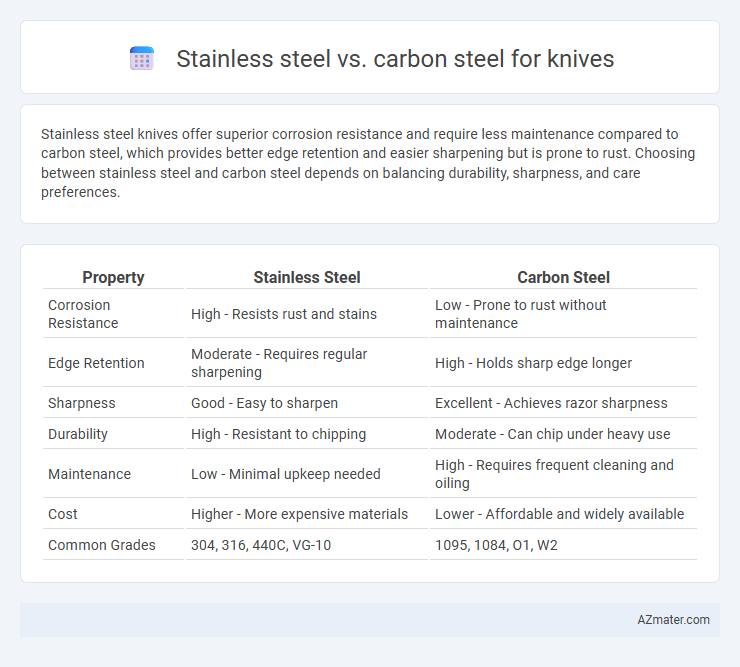Stainless steel knives offer superior corrosion resistance and require less maintenance compared to carbon steel, which provides better edge retention and easier sharpening but is prone to rust. Choosing between stainless steel and carbon steel depends on balancing durability, sharpness, and care preferences.
Table of Comparison
| Property | Stainless Steel | Carbon Steel |
|---|---|---|
| Corrosion Resistance | High - Resists rust and stains | Low - Prone to rust without maintenance |
| Edge Retention | Moderate - Requires regular sharpening | High - Holds sharp edge longer |
| Sharpness | Good - Easy to sharpen | Excellent - Achieves razor sharpness |
| Durability | High - Resistant to chipping | Moderate - Can chip under heavy use |
| Maintenance | Low - Minimal upkeep needed | High - Requires frequent cleaning and oiling |
| Cost | Higher - More expensive materials | Lower - Affordable and widely available |
| Common Grades | 304, 316, 440C, VG-10 | 1095, 1084, O1, W2 |
Introduction to Knife Materials
Stainless steel knives offer superior corrosion resistance and require less maintenance, making them ideal for everyday kitchen use. Carbon steel knives provide exceptional sharpness and edge retention but are more prone to rust and need regular care. Both materials balance durability and performance, influencing the selection based on user preferences and specific cutting tasks.
What is Stainless Steel?
Stainless steel is an alloy primarily composed of iron, chromium (at least 10.5%), and varying amounts of carbon, which provides excellent corrosion resistance compared to carbon steel. The chromium creates a thin, protective oxide layer on the surface that prevents rust and staining, making it ideal for knives used in humid or wet environments. Its balance of hardness, durability, and resistance to oxidation ensures stainless steel knives require less maintenance and retain sharpness longer in everyday use.
What is Carbon Steel?
Carbon steel, an alloy primarily composed of iron and carbon, is renowned for its exceptional hardness and edge retention, making it a preferred choice for knife blades that require sharpness and durability. Unlike stainless steel, carbon steel lacks significant amounts of chromium, which means it is more prone to rust and corrosion but offers superior ease of sharpening and a finer cutting edge. The balance of carbon content in carbon steel, typically ranging from 0.5% to 1.2%, directly impacts the blade's toughness and performance in various cutting tasks.
Edge Retention Comparison
Stainless steel knives typically offer moderate edge retention due to their chromium content, which enhances corrosion resistance but can reduce hardness. Carbon steel knives excel in edge retention because of their higher carbon content, allowing for a harder, sharper edge but requiring more maintenance to prevent rust. Choosing between stainless steel and carbon steel for edge retention depends on balancing durability with upkeep preferences.
Ease of Sharpening: Stainless vs Carbon Steel
Carbon steel knives generally offer easier sharpening due to their softer composition and higher carbon content, allowing for quicker edge restoration with basic tools. Stainless steel knives, often harder and containing chromium, resist corrosion but require more effort and specialized equipment to achieve a sharp edge. The trade-off between ease of sharpening and maintenance depends on the steel's alloy composition and the user's sharpening skills.
Corrosion Resistance in Knives
Stainless steel knives exhibit superior corrosion resistance due to their higher chromium content, typically above 12%, which forms a passive oxide layer protecting the blade from rust and stains. Carbon steel knives, although often sharper and easier to sharpen, lack this protective layer and are more prone to corrosion, especially when exposed to moisture and acidic environments. Proper maintenance such as drying and oiling is essential for carbon steel knives to prevent rust, whereas stainless steel requires less frequent upkeep for corrosion prevention.
Durability and Strength Factors
Stainless steel knives offer superior corrosion resistance due to chromium content, making them highly durable in wet or acidic environments. Carbon steel knives, while prone to rust without proper care, typically provide greater hardness and edge retention, translating to longer lasting sharpness under heavy use. The choice between stainless steel and carbon steel balances strength benefits with maintenance requirements for optimal knife performance.
Maintenance Requirements
Stainless steel knives require less maintenance due to their higher resistance to corrosion and rust, making them ideal for humid or wet environments. Carbon steel knives demand more frequent cleaning, drying, and oiling to prevent oxidation and maintain sharpness over time. Regular sharpening is essential for both types, but carbon steel typically holds an edge longer despite its greater susceptibility to rust.
Best Uses: Stainless Steel vs Carbon Steel Knives
Stainless steel knives excel in resistance to corrosion, making them ideal for kitchen environments where exposure to moisture and acidic foods is frequent. Carbon steel knives offer superior edge retention and sharper cuts, which is preferred for precision tasks and professional chefs who prioritize cutting performance. For outdoor and heavy-duty use, carbon steel's durability outperforms stainless steel, while stainless steel remains the best choice for low-maintenance, everyday kitchen knives.
Which Steel is Better for Knives?
Stainless steel knives offer superior corrosion resistance and require less maintenance, making them ideal for kitchen use and humid environments. Carbon steel knives, while prone to rust, excel in edge retention and ease of sharpening, favored by professional chefs for precision cutting. The choice depends on whether durability against rust or sharper, longer-lasting edges is the priority for the user.

Infographic: Stainless steel vs Carbon steel for Knife
 azmater.com
azmater.com